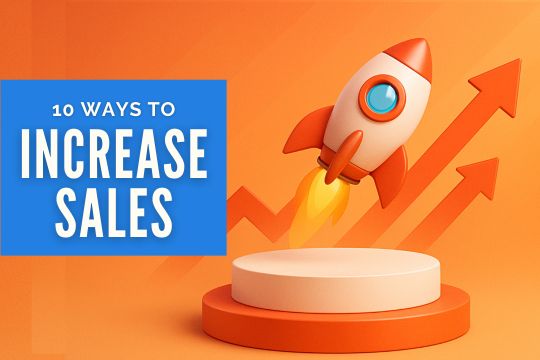
Running a small business can sometimes be a juggling act. You may be wearing all the hats in your business, and sales are some of the most critical things to manage to keep your business running and successful. Having a great product or service is half the battle. Without repeat sales, your business will struggle. The good news is that you can use several achievable strategies to boost your income, win new customers, and keep existing ones. These strategies are meant to be practical and inexpensive, which tends to work well for small business owners who don’t have larger marketing budgets.
To learn ways to increase sales for small businesses, it is important to do more than adjust advertising or prices. It involves examining your entire strategy regarding customers, from their initial introduction to your company through how you engage with them after a purchase. You should also focus on customer retention practices, refining your sales funnel, and taking advantage of opportunities to cross-sell and upsell. When you pile several strategies on top of each other, you create a system that forces revenue growth organically and generates a loyal customer base.

Selling successfully starts with understanding your target audience. Most small business owners believe they know their customers but rely on piecemeal information rather than solid data. When you take the time to learn your audience deeply, you can tailor your marketing, messaging, and offers to their specific needs, significantly enhancing your ability to make a sale.
Begin by communicating with your current customers. Use surveys, customer comment cards, and one-on-one interviews to discover why they chose your business, what they enjoy most, and how they would improve things. Look at your sales records to determine if there is a pattern in purchasing. Are some items bought together? Are there specific times of the year when customers purchase larger quantities? By segmenting your audience based on these behaviors, you can create targeted campaigns that resonate with each segment.
Understanding your customers also lets you craft messages that solve their pain points and wish lists. Customized messages perform better as they convey that you know your customers and can provide solutions that matter to them. Additionally, getting to know customer demographics and psychographics in-depth enables you to forecast trends, dial in your offerings, and craft on-target and opportune promotions. Investing time learning about your community creates the foundation for increased interaction, better conversion rates, and stronger long-term customer relationships. Learning and studying your customers' behavior can be a constant feedback loop, which keeps your small business sales strategies aligned with what your market wants. You also get to design personalized upselling tactics and targeted email campaigns that appeal to their tastes, which can significantly boost revenue in a matter of weeks.
While obtaining new customers is crucial, existing customers are usually more valuable. Studies always reveal that gaining a new customer costs more than retaining an existing one. Customer retention strategies can be one of the most efficient ways to increase sales for small businesses. Repeat customers will spend more in the long run, buy more regularly, and even refer relatives and friends to your business.
For improved retention, institute a repeat purchase loyalty program. Even providing a points system or a random discount can keep customers coming back for more. Keep the program easy so customers know the benefits and will want to participate. Following an order with a thank you note, a satisfaction survey, or additional product suggestions can reinforce the bond and help customers feel valued. The simple act of acknowledging repeat buyers solidifies emotional loyalty and encourages long-term involvement.
Rewarding with special offers and promotion previews can solidify retention even further. When customers feel that they belong to a special group, they will be more likely to come back and interact with your business regularly. Retention strategies also involve one-on-one email sequences, reminder notices about new products or seasonal offerings, and interaction through social media posts. Retention increases revenue and creates a culture of followers who can spread the word about your business naturally. Keeping your existing customers as a sales machine is one of the most affordable ways to make money quickly. Effective retention is also perfectly in line with cross-selling principles for small businesses, and you can introduce complementary products that follow up on previous orders.

One of the fastest ways to increase sales for small businesses is to extract more money from every customer with each transaction by implementing upsell and cross-sell techniques. Upselling is the sale of a higher-end version of the product or service the customer has already decided to purchase. Cross-selling suggests related or complementary products that enhance the initial purchase. Used strategically, these techniques can dramatically increase average order value and sales.
For instance, consider offering add-on services or upgrade versions of your products. Minor upgrades or enhancements will feel like a small cost to the customer but can generate a significant revenue increase for your business. Cross-selling is the same concept as demonstrating other things that naturally accompany their initial purchase to customers. Suggesting accessories, related products, or combined services can help customers reach more value while increasing your sales numbers.
The key to successful upselling and cross-selling is to treat the customer's needs rather than trying to push products. If those recommendations are seen as valuable and relevant, they enrich the shopping experience while simultaneously increasing revenue. Ongoing testing of products or services that go together keeps your offers up to date and appealing. Email marketing as a means to upsell or cross-sell is another excellent tactic. Sending targeted recommendations from purchase history, seasonal promotions, or related products can improve conversions and help your small business's selling strategies in the long run. Cross-selling ideas for small retailers could be presenting bundled seasonal products, time-limited accessory deals, or suggesting related products on checkout pages.
The sales funnel is a buyer's journey from discovering your company to buying from you. Optimizing this process maximizes the number of leads turning into paying customers and maximizes each marketing effort. A poor or complex sales funnel will result in lost potential and flat growth.
Start by scrutinizing each step of your funnel. Identify where prospects fall off. This could be a clunky checkout process, confusing product description, or slow website load. Simplifying these steps reduces friction and enables prospects to transition from interest to action more easily. Multiple payment options, transparent pricing, and simple calls to action remove barriers and encourage conversions.
Run retargeting campaigns to reclaim visitors who didn't purchase on their initial visit. Reclaiming them through tools like Google Ads, Facebook retargeting, or email reminders allows you to reconnect with interested leads. Personalized reminders of what visitors viewed or added to their shopping cart may prompt them to revisit and purchase.
Each stage must guide the customer seamlessly to purchasing, emphasizing potential for additional value. Checking analytics regularly allows you to notice which parts of the funnel perform optimally and which need adjusting. Tracking click-through, abandonment, and conversion rates will enable you to fine-tune each stage of the funnel continuously. This ongoing optimization ensures your small business sales tactics are efficient and can always generate additional sales for your small business. Funnel optimization combined with loyalty programs and referral schemes further accentuates revenue increase and customer loyalty.

Special offers can prompt customers to buy now and drive sales. Time-limited offers, seasonal promotions, and bundle deals create a sense of urgency and offer a perceived value for your goods. Making unbeatable offers is all about striking that balance between making the sale and maintaining your profit margin.
Product bundling is a simple way to make offers appealing. Pair high-demand items with complementary ones to create a package that will feel worth it to the client. Seasonal promotions, such as back-to-school offerings, holiday deals, or summer specials, capitalize on natural buying times to drive sales. Providing loyal customers early access to new products improves retention and makes your audience feel special.
Messaging must be concise. Customers need to be informed why the offer is of value, how long it will be available, and what they have to gain by doing so now. Including upsell initiatives on these offers, such as providing superior versions or complimentary items, can achieve the most revenue per customer. Testing different types of offers, such as "buy one, get one," percentage off, or time-limited bundle, lets you figure out what works best with your crowd. Successful promotions generate sales today and build long-term relationships with customers; therefore, it is a critical element of small business selling strategies. Implementing seasonal promotion principles helps keep promotions better aligned with customer expectations and increases the chances of conversion.
A good digital presence is essential to acquire and retain customers. Customers mostly search online before purchasing, so your website and social media have to be visible, worth their attention, and attractive. Your professional online presence instills confidence and makes your company reliable and accessible.
Ensure your website is mobile-friendly, optimized for speed, and easy to use. Use clear descriptions, prices, and calls to action. High-quality pictures, videos, and customer reviews boost engagement and make customers more confident purchasing. Adding free analytics tools to analyze sales data on your site can provide insights into visitor behavior, top-selling products, and conversion trends so that you can make adjustments based on facts.
Social media platforms are additional ways of interacting with your public. Posting items regularly, replying to queries, and displaying customer views enhance your authenticity. Optimizing your website and social media to be search engine-friendly attracts attention. Local SEO techniques, like stating where your company is situated and keywords thereof, can attract pedestrians and calls to your company. A clean online presence is the foundation for all other methods, from customer retention mechanisms to upselling methods. Employing email marketing, cross-selling, and promotional messaging is far more impactful if your website and online channels are solid and intuitive.
Social proof is a powerful tool for gaining customer trust and generating sales. When deciding to buy, people are likely to refer to reviews, testimonials, or case studies. Focusing on positive experiences can convert new customers and increase conversions.
Get satisfied customers to leave reviews on platforms like Google, Yelp, or social media. Highlight these reviews on your website and marketing campaigns. Responding to both negative and positive feedback shows that you value customer input and creates credibility.
Case studies or examples demonstrating how your products or services solve real problems prove value. Highlight figures such as the number of satisfied customers or projects completed. Social proof is applicable when combined with referral programs, loyalty campaigns, and email campaigns for upselling and cross-selling. It is smart to position social proof on product pages, marketing emails, and promotions, enhancing your brand and helping potential buyers feel safe buying from you.

Well-trained salespeople create revenue and make it a joy to buy from you. Even if you are a solo entrepreneur, improving your selling skills can mean improved conversion rates and revenue. Training should focus on product knowledge, communication skills, and techniques for upselling and cross-selling.
Ensure that your employees are aware of the characteristics and benefits of each product or service. Train your sales team to identify customers' needs and recommend solutions based on those needs. Role-playing activities and practicing objections increase confidence and performance in real situations.
Ongoing training keeps your sales staff updated on the best sales techniques and small business strategies. Highly skilled sales staff can recognize opportunities to generate additional revenue within the short term through repeat business, upselling, cross-selling, or referrals. Providing refreshers and gathering feedback on sales calls also sharpens tactics over time. A successful sales force is one of the most reliable ways of maintaining growth and building long-term customer loyalty.
Email marketing is a cost-effective way to reach customers. It allows you to build relationships and communicate value over time, which is required to drive sales. Smart email campaigns are crafted to be relevant to different segments in your audience with the right content that addresses their needs.
Segmenting your mailing list ensures customers get messages about their purchase habits and preferences. First-time buyers will receive a welcome series, but repeat buyers will be issued loyalty rewards or early access to promotions. Also, personalized subject lines and deals help greatly with open and click-through rates.
Track metrics like open rates, clicks, and conversions to adjust campaigns. Email marketing increases sales by upselling, cross-selling, and reminding customers about products they viewed before. Regularly sending valuable emails at the right time increases customer relationships and assists with overall small business selling strategies. Implementing a loyalty program or samples within email campaigns can trigger repeat purchases and increase revenue in the long term.
Referral programs rely on your existing customer base to generate new leads. Satisfied customers become influencers who refer friends, family, or colleagues to your shop. Structured referral programs encourage this activity by paying customers with discounts, gifts, or store credit.
To ensure a referral program's success, keep it simple and explain the rewards clearly. Promote it regularly so that customers don't forget to participate. Reward and thank people for referrals, encouraging good behavior.
Referral programs not only generate new sales but also boost customer loyalty. Customers are more likely to believe recommendations from friends or relatives than advertisements, so referrals are a very effective way to expand your small business. Merging referrals with loyalty initiatives, social proof, and email marketing can maximize results and allow you to drive revenue reliably and quickly. Incentives for referrals can be combined with holiday promotion ideas for local businesses, constructing a stronger and ongoing sales growth machine.
These feasible and cost-effective strategies make them ideal for small business owners. By utilizing even a few of these strategies, you can achieve revenue growth, establish repeat clients, and improve your company's overall performance. Contact us if you want to boost local traffic with small-business SEO.
Prioritize customer retention. Launch a simple loyalty program, send thank-you notes, and offer targeted discounts to past buyers. Repeat customers buy more often, cost less to reach than new ones, and can refer others—delivering rapid, inexpensive revenue growth.
Suggest higher-tier versions or complementary products only when they genuinely add value. Highlight clear benefits, keep price differences reasonable, and present the option politely during checkout or in follow-up emails so customers feel helped rather than pressured.
Make your site mobile-friendly, speed-optimized, and easy to navigate. Use clear product descriptions, high-quality images, visible reviews, multiple payment options, and direct calls to action. Removing friction at every step guides visitors smoothly toward completing a purchase.
Detailed knowledge of demographics, behaviors, and pain points lets you craft messages, offers, and products that resonate. Relevant communications boost engagement, raise conversion rates, inform smarter upsell opportunities, and foster long-term loyalty that sustains revenue growth.
Rewarding customers for referrals—through discounts, credits, or small gifts—turns satisfied buyers into advocates. Their personal recommendations bring in pre-qualified leads who convert at higher rates, while the incentives deepen existing customer loyalty, compounding sales over time.